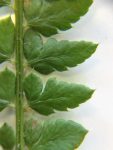Taxonomy
| Division | Pteridophytes |
| Class | Polypodipsida |
| Order | Polypodiales |
| Family | Dryopteridaceae |
Description: The following is a general description of the family characters based on those outlined in the widely-accepted classification provided by Smith et al. in the paper A Classification for extant ferns (2006):
Dryopteridaceae can be found across the tropics and in temperate regions. They are terrestrial, epipetric, or epiphytic ferns. Interestingly, some may even be hemi-epiphytic, which means they grow on another plant at one stage of its life-cycle and are rooted in soil in another stage. They also have rhizomes with scales.

Petiole cross-section of Polystichum sp. displaying vascular bundles arranged in a ring. (Photo by Teri Lim)
If you cut a cross section of the petiole you will find multiple vascular bundles arranged in a ± ring. The veins in the leaves vary and can be forking or pinnate, and free to connecting. The sori are round and may be covered by a thin flap of tissue, called an indusium, or completely lack it. If it has an indusium, it will either be kidney-shaped (reniform) or umbrella-shaped with attachment at the center (peltate).
In the UK
This family contains many familiar terrestrial ferns found in British woodlands including buckler-, male-, and shield-ferns. It also includes a couple of introduced naturalised ferns that can be found growing on walls or rocks, and other shaded & sheltered places. They grow in a shuttle-cock like form, in which the fronds (fern leaves) are born from tufts at the end of short, densely scaly rhizomes (Stace, 2006). The fronds vary with regards to number of divisions and can be 1 to 3-pinnate. The sori are always found on the underside of the frond and covered by reniform or peltate indusia. There are 3 genera that occur in the UK: Cyrtomium, Dryopteris, and Polystichum.
Distribution: Found throughout the British Isles.
Ecology: Many species commonly occur in woods, moist shady places & hedge banks. However, others occur on mountains—in open or shady areas—, rocky places, crevices, walls, ravines, and even wet heaths, marshes or fens (Stace, 2006).
On Whiteknights Campus

Left to right – P. setiferum, P, aculeatum, D. affinis, D. dilatata. (Photo by Teri Lim)
Distribution: The specimens I have personally found all occurred in The Wilderness, however, they are likely to occur in other broadleaf or mixed woodland areas bordering campus.
Ecology: Found in woodlands generally on moist soils, adjacent to tree trunks, bank of Whiteknights lake.
Species you may find on campus: Dryopteris affinis, D. filix-mas, D. dilatata, Polystichum setiferum, and P. aculeatum.
How can you tell them apart?
Dryopteris vs. Polystichum
You can differentiate the two genera found on campus by pinnule and indusia shape. Polystichum spp. have umbrella-shaped indusia with attachment at the center and pinnules with a basal lobe that faces towards the apex of the frond. It is sometimes referred to as a ‘thumb’ because it vaguely resembles a thumb’s up shape. Dryopteris, on the other hand, has kidney-shaped indusia and lacks thumbs on pinnules.
P. setiferum vs. P. aculeatum

Comparison of lowest pinna length to longest pinna length. Left – P. aculeatum, Right- P. setiferum. (Photo by Teri Lim)

Comparison of pinnule spacing, color, and distinctiveness of ‘thumb. Left – P. aculeatum, Right – P. setiferum (Photo by Teri Lim)
P. setiferum is generally a brighter green, has a more soft/limp feel to touch, a more divided or distinctive thumb, and the lowest pinnae are <1/2 the length of the longest pinnae. P. aculeatum is generally a darker, shiny green, with a stiffer feel, less divided thumb, and it’s lowest pinnae are about 1/2 the length of the longest pinnae. When laid on a flat surface, P. setiferum tends to display more gaps in between pinnae and pinnules.
D. affinis vs. D. filix-mas vs. D. dilatata
D. affinis and D. filix-mas at first glance look fairly similar to each other, so to make life easier, well get D. dilatata sorted out first. It has leaves that are 2-pinnate-pinnatisect, whereas the other 2 species are 1-pinnate-pinnatsisect. Other defining characters that are helpful for a confident ID are that its longest pinnae are at the base, its pinnules have recurved margins with a short spinulose tooth at the apex, and its scales along the petiole have an obvious dark stripe in the middle.

Dark pigmentation where pinna meets the rachis on D. affinis (Photo by Teri Lim)
Now, if you you’ve spotted a 1-pinnate-pinnatisect fern on campus with kidney-shaped indusia, check to see if there is a dark pigmentation where the pinnae meets the rachis. If it has dark spots, it’s D. affinis— if it doesn’t have any, it’s D. filix-mas.
References
Distribution maps. Retrieved February 25, 2017, from http://bsbi.org/maps
Smith, A. R., Pryer, K. M., Schuettpelz, E., Korall, P., Schneider, H., & Wolf, P. G. (2006). A classification for extant ferns. Taxon, 55, 705–731.
Stace, C. A. (2010). New flora of the British Isles (3rd ed.). Cambridge, UK: Cambridge University Press.
For field & character identifications
British Pteridological Society. (2012). Whats that fern? Find out about our common native ferns. Retrieved February 25, 2017 from http://www.ebps.org.uk/wp-content/uploads/2014/05/Fern-Guide01.pdf
Poland, J., & Clement, E. J. (2009). The Vegetative Key to the British Flora. John Poland & The Botanical Society of the British Isles, Southampton.
Stace, C. A. (2010). New flora of the British Isles (3rd ed.). Cambridge, UK: Cambridge University Press.








